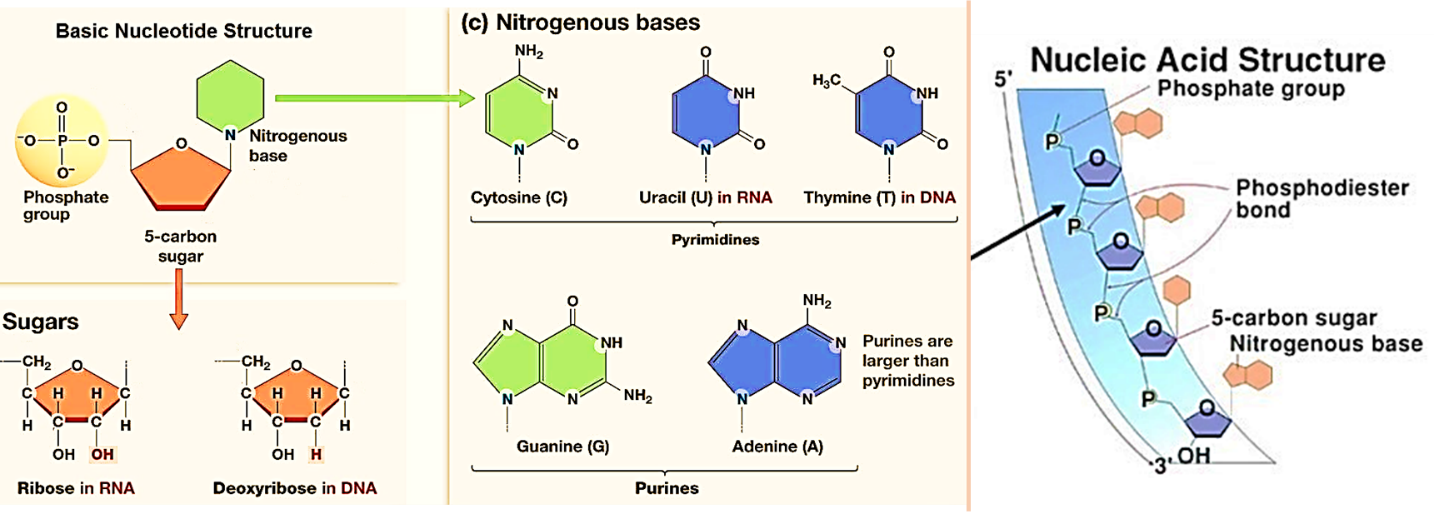Answer
425.1k+ views
Hint: DNA is a nucleic acid made up of two strands having a sugar phosphate backbone each. This sugar phosphate backbone holds the nucleotides perpendicular to the backbone. The sugar phosphate backbone is made up of alternating phosphate groups and a Deoxyribose sugar.
Complete answer:
-DNA stands for Deoxyribonucleic acid, as it is a nucleic acid made up of Deoxyribose sugar that lacks an –OH group at C2' position unlike a ribose sugar seen in RNA (Ribonucleic acid).
-The sugar is called Deoxyribose as it lacks an oxygen atom at the C2' position. The absence of this oxygen helps the enzymes distinguish DNA from RNA thus making possible the sequence specific recognition of DNA by enzymes and different proteins.
Figure 1: Nucleic acid structure

Additional information:
Apart from the sugar the DNA can be distinguished from RNA based on the nucleotides present, that is, DNA has four basic units called Adenine, Guanine, Cytosine, and Thymine. But in RNA the Thymine is replaced by Uracil, making it a distinguishing feature among DNA and RNA.
Note:
Nucleic acids are the large biomolecules that make up the hereditary material in an organism. It is basically made up of three substances: Sugar molecule (ribose or Deoxyribose), phosphoric acid, and a base (purines and pyrimidines). When a base binds to the sugar molecules it forms a nucleoside. This nucleoside then binds with phosphoric acid to form a nucleotide. Hence, a nucleic acid is known as a long chain polymer of nucleotides.
Complete answer:
-DNA stands for Deoxyribonucleic acid, as it is a nucleic acid made up of Deoxyribose sugar that lacks an –OH group at C2' position unlike a ribose sugar seen in RNA (Ribonucleic acid).
-The sugar is called Deoxyribose as it lacks an oxygen atom at the C2' position. The absence of this oxygen helps the enzymes distinguish DNA from RNA thus making possible the sequence specific recognition of DNA by enzymes and different proteins.
Figure 1: Nucleic acid structure

Additional information:
Apart from the sugar the DNA can be distinguished from RNA based on the nucleotides present, that is, DNA has four basic units called Adenine, Guanine, Cytosine, and Thymine. But in RNA the Thymine is replaced by Uracil, making it a distinguishing feature among DNA and RNA.
Note:
Nucleic acids are the large biomolecules that make up the hereditary material in an organism. It is basically made up of three substances: Sugar molecule (ribose or Deoxyribose), phosphoric acid, and a base (purines and pyrimidines). When a base binds to the sugar molecules it forms a nucleoside. This nucleoside then binds with phosphoric acid to form a nucleotide. Hence, a nucleic acid is known as a long chain polymer of nucleotides.
Recently Updated Pages
How many sigma and pi bonds are present in HCequiv class 11 chemistry CBSE

Why Are Noble Gases NonReactive class 11 chemistry CBSE

Let X and Y be the sets of all positive divisors of class 11 maths CBSE

Let x and y be 2 real numbers which satisfy the equations class 11 maths CBSE

Let x 4log 2sqrt 9k 1 + 7 and y dfrac132log 2sqrt5 class 11 maths CBSE

Let x22ax+b20 and x22bx+a20 be two equations Then the class 11 maths CBSE

Trending doubts
Fill the blanks with the suitable prepositions 1 The class 9 english CBSE

At which age domestication of animals started A Neolithic class 11 social science CBSE

Which are the Top 10 Largest Countries of the World?

Give 10 examples for herbs , shrubs , climbers , creepers

Difference between Prokaryotic cell and Eukaryotic class 11 biology CBSE

Difference Between Plant Cell and Animal Cell

Write a letter to the principal requesting him to grant class 10 english CBSE

Change the following sentences into negative and interrogative class 10 english CBSE

Fill in the blanks A 1 lakh ten thousand B 1 million class 9 maths CBSE



